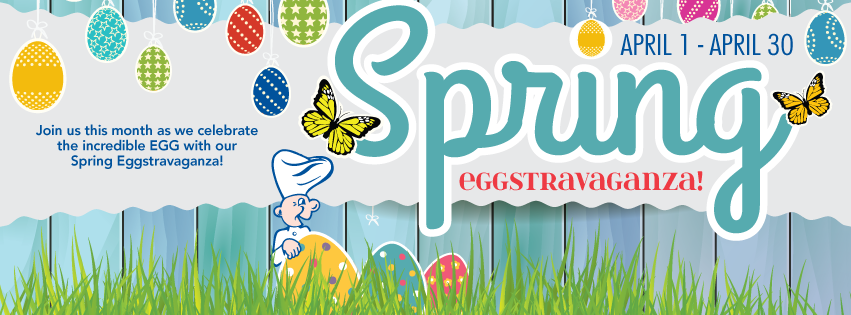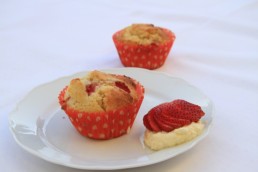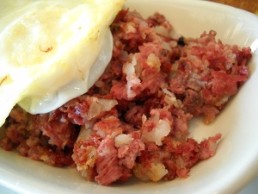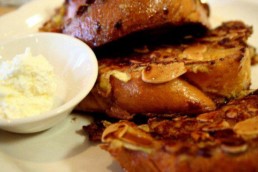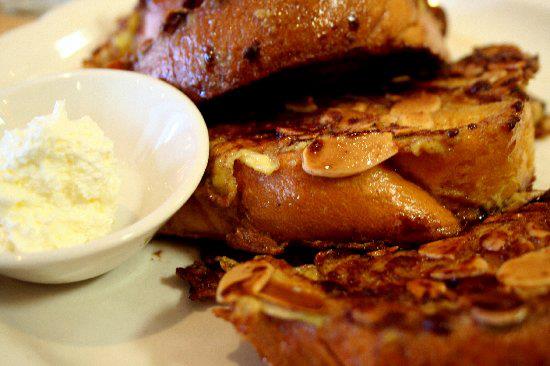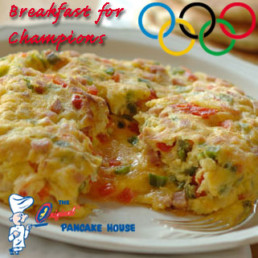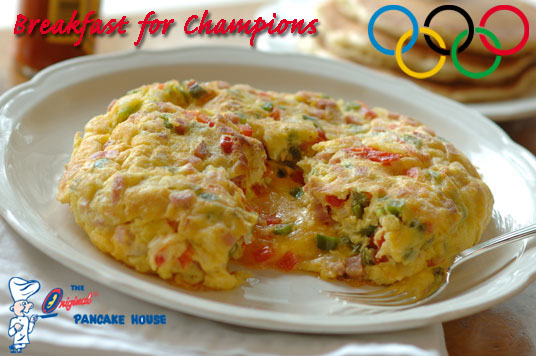Eggstra Special Easter Traditions
Brightly decorated eggs, the Easter Bunny, oodles of chocolate, and a family brunch are all integral parts of most annual Easter traditions. Since we are celebrating our Eggstravaganza at the Original Pancake House this month, we decided to explore the history of Easter eggs to find out where this tradition began.
Though today Easter eggs are associated with the Christian holiday of Easter, the tradition of decorating and painting eggs extends back to ancient times. As a symbol of life and rebirth, decorated eggs have been found in ancient civilizations in Africa, South and Central America, and Mesopotamia. For example, Iranians have been decorating eggs for many thousands of years in honor of their new year’s holiday of Nowruz, which coincides with the spring equinox. The Easter egg as we know it today may have pagan roots as part of a springtime and rebirth celebration that occurred each year and involved an egg hunt.
In the Christian religion, Easter eggs are symbols of the resurrection and rebirth of Jesus Christ. In Orthodox and Eastern Orthodox churches, eggs are dyed red to represent the blood that Christ shed on the cross. The egg’s hard shell represents the Tomb of Christ and the cracking of the shell represents his resurrection. Easter egg rolling is representative of the rolling away of the stone in front of Christ’s tomb. In A.D. 1610 under Pope Paul V, the Christian Church officially adopted the Easter egg as a symbol of the resurrection. These Easter traditions originated in Europe and Eastern Europe and were brought to the United States over the past century by immigrant families. Today we continue to celebrate Easter with many of these old traditions including an Easter egg roll on the White House lawn and backyard Easter egg hunts.
However you plan to celebrate this Easter holiday, be it with an egg hunt or just a gathering of family and friends for brunch in Denver; the Original Pancake House wishes you a very happy Easter and a wonderful spring!
Say Hello to Spring!
We've been waiting all winter and spring has finally arrived. Flowers are poking their green stems through the dirt, small blooms are popping up on sunny corners, and even the trees are starting to bud. With spring comes the annual promise of fresh produce including asparagus, strawberries, green onions, rhubarb, peas, grapefruit, and a variety of spring greens. To celebrate the return of warm weather, here are a few fresh and seasonal recipes for a delightful spring breakfast.
Artichoke Frittata
Ingredients
2 9 ounce boxes frozen artichoke hearts, thawed and quartered
1/4 cup flour
1/4 cup extra-virgin olive oil (EVOO)
12 large eggs
1/2 cup heavy cream
1/2 cup grated pecorino-romano cheese
1/4 cup chopped flat-leaf parsley
1 pinch nutmeg
Salt and pepper
Lemon wedges, for serving
Spring greens, for serving
Directions
1. Preheat the oven to 400 degrees. In a bowl, toss the artichokes with the flour to coat.
2. In a medium ovenproof skillet, heat the EVOO, 4 turns of the pan, over medium-high heat. Add the artichokes and fry until lightly golden, about 5 minutes. In a bowl, beat together the eggs, cream, cheese, parsley and nutmeg; season with salt and pepper. Pour the eggs over the artichokes and cook until just set.
3. Transfer the frittata to the oven and bake until set and golden, 10 to 12 minutes. Let cool, then slice into quarters and serve with the lemon wedges and a side of fresh spring greens
Meyer Lemon Strawberry Muffins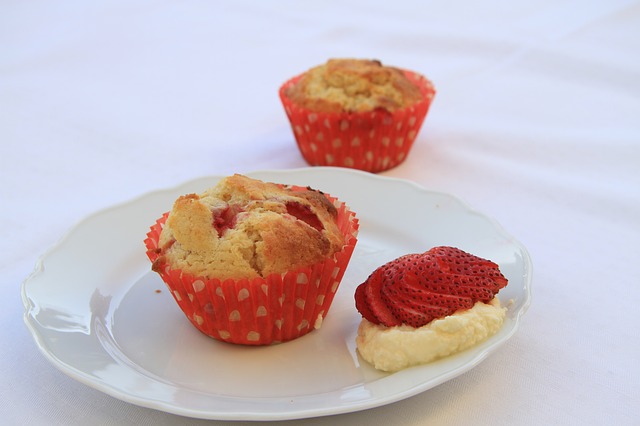
Ingredients
2 1/2 cups all-purpose flour
3/4 cup granulated white sugar
2 teaspoons baking powder
1/4 teaspoon baking soda
1/4 teaspoon salt
Zest and juice of one Meyer Lemon
1 large egg, lightly beaten
3/4 cup buttermilk
2/3 cup canola oil
1 teaspoon pure vanilla extract
2 cups chopped, fresh strawberries
Directions
1. Preheat oven to 375 degrees. Position rack in center of oven. Butter or spray with a non-stick cooking spray 12 muffin cups. Set aside.
2. In a large bowl whisk together the egg, buttermilk, oil, Meyer Lemon juice and vanilla extract.
3. In another large bowl combine the flour, sugar, baking powder, baking soda, salt, and lemon zest. Gently fold in the berries. With a rubber spatula fold the wet ingredients into the dry ingredients and stir only until the ingredients are combined. Do not over mix the batter.
4. Fill each muffin cup almost full of batter, using two spoons or an ice cream scoop. Place in the oven and bake until a toothpick inserted in the center of a muffin comes out clean, about 20 minutes. Transfer to a wire rack and let cool for about 5 minutes before removing from pan.
Spring Asparagus and Bacon Hash
Ingredients
¼ pound bacon, cut into ¼-inch dice (pancetta is also a good idea)
1 pound fingerling potatoes, peeled, cut into ½-inch dice
1 small yellow onion, diced
½ pound asparagus ends trimmed, cut into 1-inch segments
salt and pepper
2 tablespoons butter
4 eggs
Directions
1. Add bacon to a large cast iron pan set over medium heat. Cook, stirring occasionally, until browned and crisp, about ten minutes. Remove bacon with a slotted spoon and drain on paper towels.
2. Add potatoes to the pan, stir well until they are coated in the rendered fat, and then spread them out into a single layer. Season with salt and pepper, and cook without stirring until lightly browned on the bottom. Using a spatula, flip the potatoes and cook until lightly browned. Continue this process until all sides are lightly browned, about 15 minutes total.
3. Add onion to the pan and stir well. Cook until onions are softened, about five minutes. Add the asparagus, stir well, and then cover the pan. Cook, stirring occasionally, until asparagus is crisp and tender, five to eight minutes. Return the bacon to the pan, stir, and let cook for a minute until warm. Season with salt and pepper to taste.
4. Serve with scrambled eggs, fried eggs or poached eggs.
Of course, if these recipes sound like too much work, why not take yourself out to breakfast in Denver? At the Original Pancake House, we would be happy to serve you one of our spring favorites such as the Strawberry Belgian Waffles or our Florentine Omelet! Happy spring!
Irish Breakfast Traditions
In honor of St. Patrick’s Day, we thought we’d explore Irish breakfast traditions. The morning after all the St. Patrick’s Day revelry, we figured the good folks in Ireland must sit down for a hearty meal. As it turns out, a full Irish breakfast is nothing short of a small feast! Here are a few breakfast staples from the Emerald Isle:
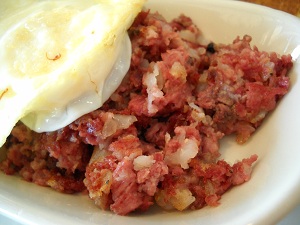
Rashers – Rashers are the Irish version of bacon. This pork treat more resembles Canadian bacon, although it is a fattier cut and is served as a round patty. Where American bacon is traditionally cooked until crispy, rashers are typically fried in Irish butter until cooked through and lightly browned.
Bangers – Bangers are a traditional Irish breakfast sausage. Either made with pork or a combination of pork and beef, bangers are typically short in length and fat in diameter. The word “banger” refers to the sausage’s tendency to split and explode out of its casing when cooked.
Boxty – Considered a traditional Irish potato pancake, the boxty actually more resembles American hash browns. Riced potatoes are compacted into a pancake shape within a hot skillet and fried to make this breakfast staple.
Black & White Pudding – Black pudding is essentially blood sausage, or cooked and congealed blood from pigs or cows mixed with pork, beef, or sometimes oatmeal, bread or potato. White pudding is a similar soft sausage made without the blood. Both varieties are usually sliced and then grilled or fried.
And more still! – All Irish breakfasts are served with fried eggs. In addition, a full Irish breakfast will include Irish brown bread, baked beans, fried tomatoes, and sautéed mushrooms. Whew! With a meal this large, you are sure to have energy for a full day’s work or fun! If you don’t want to fly all the way to Ireland for your next morning meal, we’d be happy to serve you an Irish inspired breakfast in Denver at the Original Pancake House with our very own Corned Beef Hash and Eggs. From all of us at the Original Pancake House, Happy St. Patrick’s Day!
The Delicious History of French Toast
At the Original Pancake House, one of our favorite brunch menu items is French toast with a rich French toast history. In fact, we love it so much, we offer four different types on our breakfast menu including Sourdough French Toast, Seasonal Berry French Toast, Cinnamon Almond French Toast, and the Denver breakfast favorite, Banana Praline French Toast.
With French toast on our minds, we were wondering, where did this delightful dish originate? We were intrigued to find that, though the name implies a French origin, the first mention of this meal appears in Roman times. In a cookbook attributed to Apicius, from the 4th or 5th century, a recipe simply called “aliter dulcia," or “another sweet dish,” describes soaking.
Bread in a milk and egg mixture, frying in oil, and then serving with honey. French toast next appears in medieval cookbooks throughout Europe. In France, it was called “pain perdu” or “lost bread,” which probably referred to the fact the cooks used stale or old bread in this dish with a fascinating French toast history. German, English, and Scandinavian cookbooks refer to the dish as “poor knights” bread, which is also a nod to the use of old bread.
The first references to this ancient dish as “French toast” appear in the late 18th century in North America. In New Orleans, the dish maintained its original French name of “pain perdu.” However, in English speaking areas of the North American colonies, the dish became known as French toast as it was popularized by French immigrants.
So, the next time you are out for breakfast in Denver, share the ancient history of French toast with your fellow diners. It is a fascinating story!
Breakfast of Champions: What are Olympic athletes eating?
With the 2014 Winter Olympics underway, we were wondering, what is the true breakfast of champions? With nutrition being just as important as the innumerable hours spent training for the Olympic Games, what do Olympic athletes eat for breakfast? With a bit of research, we found some astounding facts. Did you know that many Olympians, especially those in endurance sports, require 9,000 to 12,000 calories per day?! Amazing! If we were so lucky as to have one of these athletes join us for breakfast in Denver, we might have to serve them one of each item on The Original Pancake House Denver menu!
For a day of training and competition, we found that Olympians focus on a substantial, yet healthy, breakfast. After all, this first meal provides the foundation of energy needed to go for the gold. In general, Olympians start their day with a healthy mix of carbohydrates, fruits and protein. Many will combine a large bowl of whole grain oats with fresh fruit, and milk or yogurt. In addition, you will likely see athletes enjoy eggs, a great source of lean protein, with toast or a bagel for additional energy. Some athletes are reported to eat a whopping 12 eggs for their first meal of the day! And because they continually burn so many calories between training and competition, you will often see competitors munching on bananas and enjoying a glass of chocolate milk to keep their energy high.
From The Original Pancake House Denver, we wish all the athletes on Team USA “good luck” in the 2014 Sochi Olympic Games. And for the twenty Coloradoans competing in Sochi, we would love to have you stop by for an Olympic-worthy breakfast in Denver when you return home!


